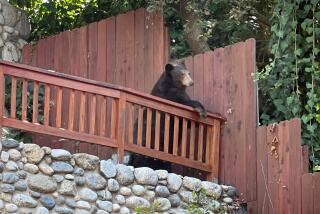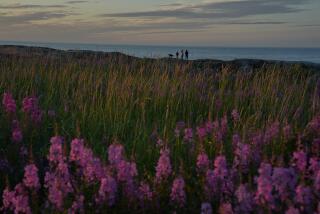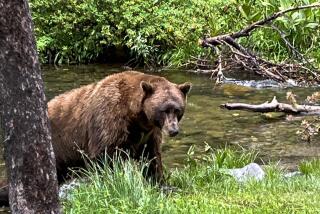Tracking Polar Bears in Manitoba Can Give Anyone Case of Cold Feet
- Share via
CHURCHILL, Canada — It was dawn in the frozen north. Sometime during the night, our train had edged out of Manitoba’s prairie and into the first fringes of birch forest. Our guide was pointing out the twiggy mounds that are beaver lodges when we saw the old man.
He was dressed in white long johns and leaning out the open window of a low, split-log cabin that sat in the middle of nowhere, in the woods. The scene was unreal, almost like a museum exhibit.
But then, this whole trip didn’t seem quite real. We were on Via Rail’s “Hudson Bay,” a train that was taking us first into the past, then to the edges of North America’s last true frontier.
We were on our way to the town of Churchill, Manitoba, 500 miles south of the Arctic Circle, to see polar bears. It was fall and it was cold. But first, there was the train.
For 1,000 miles--two nights and a day--we traveled through an increasingly harsh landscape, past towns with names like Flin Flon Junction and Moose Nose Lake and Pukatawagan, finally getting to an area where there are no roads, where the rail line is the only highway in and out.
Past Thompson and the last set of gravel ruts, we started picking up fur trappers. Alex Brightnose, 64, was a stocky, weathered Cree Indian with a wide, flat face and cauliflower ears. He looked the part and, indeed, has been trapping for 37 years . . . full-time since the Thompson nickel mines said he was too old for mining.
Alex has 30 miles of trap lines and, in a good year, earns maybe $4,000. He gets beaver and mink mostly. They fetch $100 apiece. If he’s really lucky, Alex gets a lynx, good for $700 if it’s in top-notch shape. All this he does in a land where mid-winter temperatures can easily drop to 50 below zero.
The train is a link to a past when railroads were vitally important transportation. Trappers such as Alex use it as we would use a car, hitching rides for groceries or to visit friends down the line.
As for us, we rumbled on through the night. Right on time the next morning, we pulled into Churchill, a two-square-mile collection of plain stucco buildings.
Churchill would be one more forgettable Manitoba town except for a couple of things. First, sitting on the mouth of the Churchill River at the edge of Hudson Bay, it’s a major shipping port.
Hard as it may be to picture looking at a map, Churchill is 1,000 miles closer to Europe than Montreal and 1,200 miles closer than Halifax. Thus, grain grown in the middle of Canada is shipped to Europe through here.
But most important from the tourists’ standpoint, Churchill is where you come to see polar bears.
The bears are here because they’ve always been here. Each winter, they roam the ice on Hudson Bay in search of seals. Then as the ice melts, they’re forced ashore and spend the summer lazing around. Come fall, they’re restless and hungry. They head for the bay’s coastline, anxiously prowling around and waiting for the bay to freeze up. Once that happens, they’re gone.
The tiny town of Churchill, population 800 in winter, just happens to be in the way of all this. As far back as the first European settlements in the 17th Century, people were writing home about the bears.
And with good reason: A full-grown male bear, after a winter’s gorging, can easily weigh 1,200 pounds. One huge beast was measured at nearly 1,800 pounds.
Yet, even with all that weight, the average bear can run 35 m.p.h., and drag a 200-pound seal from the water and kill it in seconds. He is also the perfect cold-weather machine. The hairs of his cream coat are actually hollow to better trap and transmit warmth to his black skin. He’s well-padded with fat, and his foot-wide feet are carpeted with rough skin for traction on ice and with fur for walking in snow.
So besides a ring of traps and warning signs throughout the town, there are other accommodations made for bears in Churchill. On Halloween, for instance, local firemen and Mounties patrol the streets to keep trick-or-treaters safe.
What with this kind of care, it’s been years since anyone was injured by a bear. The last was a local man who had been rummaging through a burned building at midnight and stuffed hamburger meat in his pockets.
Most bear sightings, especially those by tourists, are made from the safety of a special tundra bus. And that’s exactly what we were scheduled to do.
We headed out in one of the original Tundra Buggies . . . a tall, boxy contraption on huge tires that looks like a bus on fat stilts. Each buggy holds 28 people and has a toilet and a viewing platform.
For half an hour, we bounced across the tundra. The land is absolutely flat, unrelieved except for pebbles and an occasional boulder. It looks, in fact, like an endless beach, though in this case it’s an incredibly fragile one.
Out here, where the wind-chill factor in winter can cause temperatures to reach the equivalent of 100 below, everything moves and grows slowly. Tiny evergreens, hardly four feet tall, are 500 years old. Willows stand barely two feet high. Berry bushes (with full-size berries) reach maybe six inches.
This is why the buggies sit on such fat tires. The six-foot-high, four-foot-wide tractor tires have only five pounds of pressure per square inch, meaning they can roll over the tundra with less force than a person walking.
For an hour or so, we saw bears in the distance--bears playing on the horizon, bears by other buggies, but nothing near enough for us to take pictures. Then someone shouted, “Bear ahead!”
The closer we got, the rangier he looked. We could see the skin hanging from his body. He plodded up to our companion buggy and sniffed the side, burying his head in a wheel well.
Then the bear turned and came our way, shaking his head back and forth as if trying to figure us out. Finally he walked off, the sunlight still playing off his sides and the shadows accentuating the folds of his skin. We, too, went on heading farther east.
Our goal that day was a 70-foot-high mound called Knight’s Hill, really a drumlin, a pile of rock and sediment thrust up by glaciers as they ground their way through this area eons ago.
Our brief stop at Knight’s Hill was magnificent. We stood among the sprigs of willow and heather while the low northern sun made the rust-colored lichen glow. This was our only chance to actually get on the ground because from high on the hill, it was easy to see anything coming. Even so, the buggy drivers and guides walked the perimeter with rifles.
On our way back, we briefly visited the tundra camp. From a distance, it looked like a Rube Goldberg affair--a generator wagon in back, a boxy dormitory and viewing platform in the middle, a school bus made into a diner in front. The camp sleeps 16 and has become a gathering spot of sorts for bears.
Sure enough, we were not disappointed that afternoon. Six bears lounged on the ground, some with heads resting on paws, two nuzzling each other and a couple more just sitting there. As we pulled up, one of the bears stood on his hind legs and stared while a half-dozen photographers on the viewing platform jostled for position.
Then our own buggy exploded into action as windows popped open and 15 cameras clicked away. We had been hoping for one, maybe two bears this day. Our hopes were far exceeded.
More to Read
Sign up for The Wild
We’ll help you find the best places to hike, bike and run, as well as the perfect silent spots for meditation and yoga.
You may occasionally receive promotional content from the Los Angeles Times.






